Introduction
Leatheling is an emerging material that is revolutionizing industries by offering a sustainable alternative to traditional leather. By combining the aesthetic appeal of leather with eco-friendly production methods, Leatheling promises to meet the growing demand for environmentally conscious products. This article delves into the world of Leatheling, exploring its benefits, applications, comparisons with traditional leather, and much more.
What is Leatheling?
Leatheling is a synthetic material designed to mimic the appearance and texture of traditional leather. It is typically made from a combination of natural fibers, plant-based materials, and biodegradable polymers. Unlike conventional leather, which requires animal hides and extensive chemical processes, Leatheling is produced with a focus on sustainability. As a result, it is both cruelty-free and environmentally friendly, making it an appealing choice for consumers seeking ethical alternatives to leather.
The Benefits of Leatheling
Leatheling brings several significant benefits, both in terms of its environmental impact and its practical use. The key advantages include sustainability, ethical production, durability, and cost-effectiveness. Let’s break these down further.
Sustainability
One of the most compelling reasons to choose Leatheling over traditional leather is its sustainability. Leatheling is produced from renewable resources, such as plant-based fibers, and often incorporates biodegradable or recyclable materials. This greatly reduces its carbon footprint compared to traditional leather, which involves extensive water use, deforestation, and harmful chemical treatments. By shifting to Leatheling, manufacturers and consumers can contribute to a more sustainable future.
Ethical Production
Unlike leather, which involves the use of animal hides, Leatheling is cruelty-free. As a synthetic material, it eliminates the ethical concerns associated with animal slaughter for leather production. This aspect makes it highly attractive to consumers who prioritize animal welfare and wish to reduce their consumption of animal-based products.
Durability
Leatheling’s durability is comparable to, or even exceeds, that of traditional leather. It is resistant to wear, tear, and staining, ensuring that products made from Leatheling maintain their quality and appearance for an extended period. In fact, Leatheling can be more resilient to environmental factors such as moisture, fading, and cracking than real leather.
Cost-Effectiveness
Compared to genuine leather, Leatheling is generally more affordable to produce. Traditional leather can be costly due to the complex tanning process and the cost of animal hides. Leatheling, on the other hand, can be produced at a lower cost, making it an attractive option for consumers who want a high-quality, eco-friendly material at a budget-friendly price point.
Applications of Leatheling
Leatheling’s versatility makes it suitable for a wide range of industries, from fashion and automotive to home decor and sports equipment. Below are some of the most popular uses of Leatheling.
Fashion Industry
The fashion industry has quickly adopted Leatheling as a sustainable alternative to traditional leather. Designers are using Leatheling to create handbags, jackets, shoes, belts, and other fashion accessories. Leatheling’s ability to mimic the texture and appearance of real leather, along with its variety of colors and finishes, allows designers to create stylish, durable, and eco-conscious products.
Automotive Industry
The automotive industry has embraced Leatheling for use in car interiors. Car seats, steering wheels, and upholstery made from Leatheling offer a luxurious appearance and feel, similar to real leather. Furthermore, Leatheling’s resistance to fading, staining, and wear makes it a practical choice for automotive applications. As car manufacturers increasingly focus on sustainability, Leatheling presents a strong alternative to traditional leather.
Furniture and Upholstery
Leatheling’s durability and easy-to-clean properties make it ideal for use in furniture and upholstery. Sofas, chairs, and cushions crafted from Leatheling are not only long-lasting but also resistant to stains and moisture, making them perfect for homes with children or pets. Its eco-friendly nature further appeals to consumers seeking environmentally responsible alternatives for home furnishings.
Sports Equipment
Leatheling is also finding its place in the sports industry, where it is used to make footballs, baseball gloves, hiking boots, and other athletic gear. Leatheling’s moisture resistance, strength, and high wear tolerance make it an excellent choice for equipment that undergoes heavy use and exposure to the elements.
Leatheling vs. Traditional Leather
When comparing Leatheling with traditional leather, it is important to consider various factors, including environmental impact, ethical concerns, cost, and performance. Below is a detailed comparison of these two materials.
| Aspect | Leatheling | Traditional Leather |
| Environmental Impact | Produced using biodegradable or recyclable materials, reducing waste. | Leather production contributes to deforestation, water usage, and pollution. |
| Ethical Considerations | Cruelty-free, no animal hides used. | Involves the use of animal hides, raising concerns about animal welfare. |
| Cost | Generally more affordable due to lower production costs. | Can be expensive due to costs associated with animal farming and tanning processes. |
| Performance | Offers superior properties like water and stain resistance. | Known for natural breathability but may require special care to maintain its quality. |
How Leatheling is Made
Leatheling is produced through a combination of natural and synthetic materials. The production process typically involves the following steps:
- Harvesting Raw Materials: The process begins with gathering plant-based fibers, such as cotton, hemp, or bamboo, which are used as the foundation of Leatheling.
- Blending and Molding: These fibers are then combined with biodegradable polymers, which provide the material with the flexibility and durability needed to mimic real leather. The mixture is molded into sheets or rolls, depending on the intended use.
- Texturing: The Leatheling is then embossed or textured to replicate the grain and appearance of genuine leather. This step is crucial for giving Leatheling its characteristic look and feel.
- Finishing: Finally, the material undergoes a finishing process where dyes and coatings are applied. These can be customized to achieve different colors and finishes, ranging from matte to glossy.
Caring for Leatheling Products
Leatheling is easy to care for, making it a practical choice for consumers. Here are some tips for maintaining Leatheling products:
Cleaning
Leatheling is generally easy to clean. A damp cloth with mild soap can be used to wipe away dirt and stains. Avoid using harsh chemicals or abrasive cleaners, as these could damage the surface.
Storage
Store Leatheling products in a cool, dry place away from direct sunlight to prevent fading. Unlike genuine leather, Leatheling does not require regular conditioning, but it is important to keep it free from moisture and excessive heat.
Maintenance
While Leatheling is low-maintenance, it should be periodically checked for signs of wear and tear. If any damage occurs, Leatheling can often be repaired with a simple patch or by applying a layer of protective coating.
The Future of Leatheling
As consumer demand for sustainable and ethical products continues to grow, Leatheling’s future looks bright. Several industries, including fashion, automotive, and home decor, are increasingly adopting Leatheling as a viable alternative to traditional leather. This shift is driven not only by consumer preferences but also by regulations and initiatives aimed at reducing the environmental impact of manufacturing processes.
Leatheling’s potential for mass adoption is significant. With improvements in production methods and technology, the material’s cost will likely decrease further, making it even more accessible to a broader range of industries and consumers. Furthermore, as more manufacturers adopt eco-friendly practices, Leatheling’s role in the global market will continue to expand.
Conclusion
Leatheling offers a sustainable, ethical, and cost-effective alternative to traditional leather, making it an ideal choice for industries and consumers alike. Its benefits, such as sustainability, durability, and versatility, ensure its growing popularity in applications ranging from fashion to automotive to furniture. As demand for environmentally conscious products rises, Leatheling is poised to play a significant role in shaping the future of material innovation.
The transition toward Leatheling represents a positive shift towards more responsible production methods, offering a way to reduce our environmental footprint while maintaining the quality and aesthetic appeal of leather-based products. With its wide range of applications and long-term benefits, Leatheling is set to be a game-changer in various industries, marking a new chapter in the evolution of materials.





